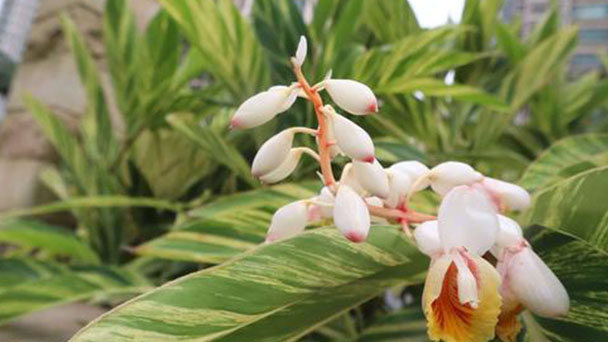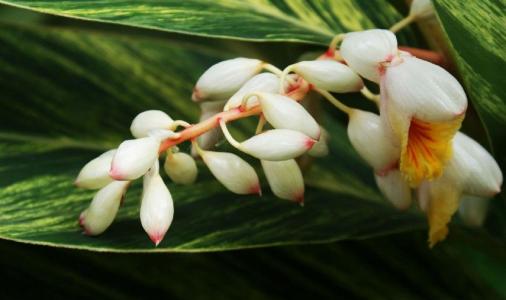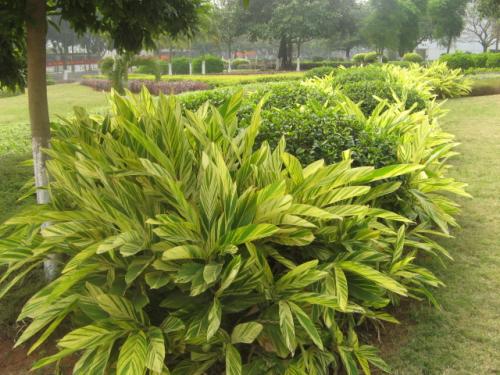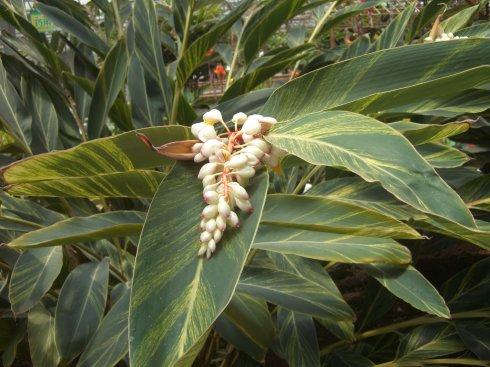Shell Ginger Profile
Written by Maggie
Dec 03 2021

Shell Ginger, scientific name Alpinia zerumbet is a perennial herb of the genus Zingiberaceae. It is native to China and India and cultivated for the horticulture of Ginger. The leaves are gorgeous and attractive; Beautiful flowers, pure fragrance of flowers, is a very ornamental value of plants. It can be put in the room, hall corridor, window sill and other bright places, and can also be cultivated outdoors, such as courtyard, pool side, park and other places as ornament plant.
Shell Ginger picture

Shell Ginger morphology characteristics
Shell Ginger (Alpinia zerumbet) is a perennial evergreen herbs, plant height about 1m, rhizome transverse. Leaves are leathery, short stipitate, rectangular oblanceolate, 50 -- 60 cm long, 10 -- 15 cm wide, green with irregular golden vertical stripes, light green back, pubescent margin. Flowering period is in early summer, panicles, pendulous, bracts white, margin yellow, apex and base pink, calyx dumbbell-shaped, corolla white.
Shell Ginger's growth habits
Shell Ginger (Alpinia zerumbet) likes high temperature and wet environments, not cold, afraid of frost and snow, likes the sun, and is shade tolerant. The suitable temperature for growth is 22-28%, and the temperature in winter is not lower than 5℃. shell ginger is sensitive to light, light is insufficient, the leaves are yellow, not bright, too dark light, the leaf color will become dark, the soil should be fertile and good moisture loam.
Shell Ginger propagation method
Substrate propagation is often used. Dig underground roots in spring and summer. Cut off the ground part of the stem and leaves, cut the rhizome 4 to 5 cm, with 2 to 3 stalks, pot directly. After planting, temporarily put in half shade for conservation, and return to normal management after germination of new buds. The origin of the country of origin is also used for sowing propagation. After seed collection, it is necessary to sow immediately. The sowing temperature is 25-30 ℃, and the germination is 15 to 20 days after insertion.

Shell Ginger culture method
1. Soil requirements:
Shell Ginger (Alpinia zerumbet) cultivated soil with loose, well-drained and well-ventilated substrates. Domestic peat can be used for planting, and the peat can be mixed well with water before being planted in the cup. In spring and summer, dig out the underground rhizome, cut off the aboveground part of the stem and leaves, cut the rhizome and plant, put the planted plants in half shade for conservation, and return to normal management after the germination of new buds.
2. Watering requirements:
Shell Ginger (Alpinia zerumbet) is divided into pots and then irrigated with roots or water permeable once. Because its root system was very damaged, water absorption ability is very weak, it will take about 3 ~ 4 weeks to restore the germination of the new root. Therefore, the points of moderation within 3 ~ 4 weeks after watering roots to rot, but its leaf transpiration is not affected. In order to maintain the water balance of the blade, we need to spray 1 ~ 3 times a day. Shell Ginger likes semi-shade and to grow, Shell Ginger needs to control the moisture level of the soil and the temperature of the soil should be between 15 and 25 degrees. Although Shell Ginger likes wet soil, it has a strong drought tolerance, so Shell Ginger also needs to see wet as well as dry, which is more conducive to plant growth.
3. Fertilization requirements:
Fertilize once a month in the growing period, with phosphorus and potash as the main fertilizer. The soil in the basin is kept moist. Water is often sprayed on the leaves in summer and autumn, and the spots on the leaves will be more obvious in midsummer. When growing outdoors, choose well-drained loose loam, see more sunshine in late spring and early summer, a little shade in midsummer, autumn and winter will be dug out and put indoors for storage. When the surface of the basin soil is already dry, which ensures that the soil is fully absorbed by the fertilizer. Shell Ginger should not over fertilize the pot when it has just been repotted or when the stems and leaves are not strong enough.
4. Planting requirements:
Take the mother plant out of the pot, shake off the excess soil from the pot, and separate the tangled roots as much as possible. With a sharp knife, it is cut into two or more plants, each with a corresponding root system, and its leaves are properly pruned to help it survive. After dividing the plant, also paying attention to the sun is too strong, and it should be placed in the shade shed maintenance.
Shell Ginger main value
Shell Ginger viewing value
Shell Ginger (Alpinia zerumbet) has beautiful leaves. June-July flowering, elegant flower appearance, attractive flowers, potted suitable hall, windowsill, stair display outdoor cultivation ornament courtyard, pool or corner, emerald bright run, unique.
Shell ginger utility value
Viewing: Shell Ginger is generally used for landscape stone side or green edge and a corner of the courtyard. Its ornamental effect is very good, very charming, and also has a high ornamental value of indoor foliage plants. Planted in the stream or under the shade can give a person to return to nature to enjoy the joy of the wild.

Latest Updated
- Benefits of Bugleweed - 7 Science-backed Health Benefits
- Bugleweed Dangers & Side Effects - Is It Poisonous?
- How to Plant Evergreen Trees - What You Should Know
- When to Plant Evergreens - Grow Guide for Evergreen Trees
- 12 Wonderful Evergreen Shrubs for Your Garden
- 12 Popular Evergreen Plants with Pictures for Beginners
- When And How To Prune A Lilac Bush Like a Pro
- How to Grow & Care for Lilac Vine (Hardenbergia Violacea)
- Japanese Lilac Tree (Syringa Reticulata) Care & Propagation Guide
- Shumard Oak Pros and Cons - What to Know
Popular Articles
- Winter maintenance of Antirrhinum Majus
- How to Grow Terminalia Mantaly Tree
- How to Grow and Care for Crossostephium Chinense
- How to grow Antirrhinum Majus in spring
- Peristeria Elata (Dove Orchid) Profile: Info & Care Guide
- Underwatered Snake Plant (Sansevieria Trifasciata) - Signs And How To Fix
- How to Care for Brazilian Jasmine Plant (Mandevilla Sanderi)
- How to Grow & Care for Graptopetalum Purple Delight in Summer
- Rosa Chinensis (China Rose): Plant Growing & Care Tips
- How to Care for Baby Sun Rose (Aptenia Cordifolia)